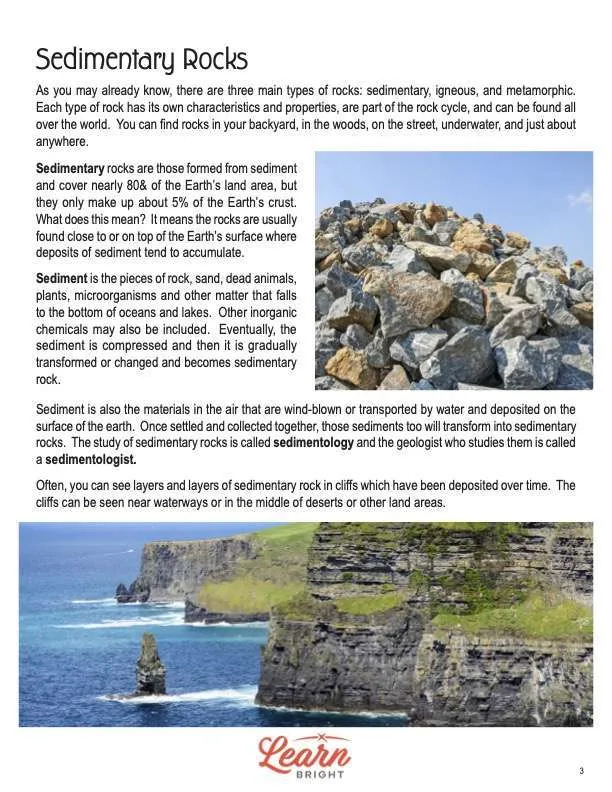Have you ever wondered what Earth was like before Instagram and TikTok existed? Well, lucky for you, fossils and sedimentary rocks are like the ultimate throwback Thursday posts, offering a glimpse into the good old days when dinosaurs roamed and rocks were laid down in layers like a rustic lasagna. Join us on a journey through time as we unearth the secrets of Earth’s history through the study of these ancient relics. It’s like CSI: Prehistoric Edition, but with way cooler evidence.
Exploring the Layers of Time: An Introduction to Sedimentary Rocks
Have you ever stopped to consider the fascinating layers of time that are hidden within sedimentary rocks? These rocks are like historical records, capturing snippets of ancient environments and the creatures that inhabited them. As we embark on this journey of exploration, we will peel back the layers of time and uncover the stories that lie within.
Picture yourself standing in front of a towering cliff face, each layer representing a different chapter in Earth’s history. From the sandy beaches of long-lost oceans to the muddy riverbeds of prehistoric swamps, sedimentary rocks hold clues to our planet’s past like a geologic time capsule. As we delve deeper into the layers, we will encounter fossils that offer a glimpse into the creatures that once roamed the Earth.
Join us as we unravel the mysteries of sedimentary rocks and discover how these humble stones have shaped our understanding of the Earth’s history. Through our exploration, we will learn about the processes of deposition, compaction, and cementation that transform loose sediments into solid rock layers. With each layer we uncover, we will gain a deeper appreciation for the intricate dance of time and geology that has shaped our world.
Discovering the Trace of Life: How Fossils Form in Sedimentary Rocks
Have you ever wondered how fossils form in sedimentary rocks? It’s like nature’s way of playing hide and seek, but instead of tagging someone’s back, it’s tagging the past!
Picture this: eons ago, a creature walks the Earth minding its own business when suddenly it meets its demise. Cue the dramatic music! Its body quickly gets buried in layers of sediment, like the ultimate burial fashion statement. Over time, the bones start to decay and mineral-rich water seeps into the tiny spaces, slowly turning the bone into a rock. Talk about a make-over!
So, how do we discover these traces of life? It’s like a treasure hunt, but instead of digging for gold, we’re digging for ancient critters. Paleontologists use their keen eyes to spot the subtle differences in rock textures and colors, like nature’s CSI team hunting for clues.
And voilà, after years of digging and detective work, we uncover the fossilized remains of creatures long gone. It’s like stumbling upon a time capsule from the past, a snapshot of ancient life preserved in the rocks. Who knew rocks could hold such juicy secrets?

Unraveling Earth’s Past: Using Fossils to Piece Together History
Fossils are like the ultimate puzzle pieces. They give us a glimpse into Earth’s past, allowing us to piece together its mysterious history. Just imagine sitting down with a 65 million-year-old T-rex and asking it about its favorite snacks! Unfortunately, fossils don’t come equipped with voice boxes, so we have to rely on some good ol’ detective work.
One of the coolest things about fossils is that they can come in all shapes and sizes. From tiny Trilobites to enormous Mammoths, each fossil tells a unique story about the creatures that once roamed the Earth. It’s like going on a prehistoric scavenger hunt, searching for clues that will unlock the secrets of our ancient world.
But here’s the kicker – not all fossils are created equal. Some are beautifully preserved, while others look like they’ve been through a Jurassic horror movie. It’s like trying to solve a mystery using a mix of Monet paintings and scribbles on a napkin. But hey, that’s all part of the fun!
So next time you stumble upon a fossil, remember that you’re holding a piece of history in your hands. Take a moment to appreciate the incredible journey that rock has been on, from the depths of the Earth to the palm of your hand. Who knows, maybe that dinosaur bone you found will be the missing piece to a scientific breakthrough!

Decoding the Clues: Examining Fossilized Life Forms in Sedimentary Rocks
Have you ever wondered what dinosaurs were really like? Well, forget Jurassic Park because we’re diving deep into the world of fossilized life forms in sedimentary rocks. It’s like being a paleontologist, except without all the dust and danger.
First things first, let’s talk about how these fossils even get there in the first place. It’s like Mother Nature playing hide and seek with us – burying these ancient creatures for us to find thousands of years later. Talk about an elaborate game of peekaboo!
When we start digging into these rocks, it’s like uncovering a prehistoric treasure chest. Imagine unearthing a trilobite or a saber-toothed tiger - it’s like finding a real-life Pokémon card. And don’t even get me started on the mystery of why these critters disappeared. Maybe they just got tired of playing hide and seek?
So, next time you spot a sedimentary rock, remember there’s more to it than meets the eye. Who knows what secrets lie beneath the surface? Maybe one day you’ll decode the clues and uncover the next big discovery in the world of ancient life forms!

Uncovering Earth’s Secrets: Interpreting Sedimentary Rock Layers
Have you ever wondered what stories the layers of sedimentary rocks beneath our feet hold? It’s like Earth’s own personal diary, but instead of juicy gossip, we get to uncover ancient secrets!
Each layer of sedimentary rock is like a chapter in a book, telling us about the different environments and events that have shaped our planet over millions of years. From sandy beaches to muddy swamps, these rocks hold clues to the past that geologists love to decipher.
By examining the different types of sedimentary rocks and the fossils they contain, we can piece together the puzzle of Earth’s history. It’s like playing detective, but instead of solving crimes, we’re piecing together the history of our planet!
So next time you’re walking on a beach or hiking through a canyon, take a moment to appreciate the layers of sedimentary rocks beneath your feet. Who knows what secrets they might be hiding!
Tracing the Evolutionary Timeline: Studying Fossils Embedded in Sedimentary Rocks
Are you ready to embark on a journey through time and uncover the secrets of evolution? Let’s dive deep into the world of fossils embedded in sedimentary rocks!
Imagine a detective searching for clues to solve a mystery. That’s what paleontologists do as they study fossils to piece together the evolutionary timeline. These ancient remnants, preserved in sedimentary rocks, hold the key to understanding the history of life on Earth.
As we sift through the layers of sedimentary rocks, we uncover a treasure trove of fossils dating back millions of years. From the tiny trilobites to the mighty dinosaurs, each fossil tells a unique story of adaptation and survival. It’s like reading a thrilling novel, except this one spans billions of years!
Join us on this exciting adventure as we unravel the mysteries of the past and gain a deeper understanding of how life on Earth has evolved over time. Who knows what hidden gems we’ll unearth as we trace the evolutionary timeline through fossils embedded in sedimentary rocks!
FAQs
What are fossils and how do they help us uncover Earth’s history?
Fossils are like the Earth’s ancient artifacts, preserving the remains of plants and animals from millions of years ago. By studying fossils, scientists can piece together the puzzle of Earth’s past, from the creatures that roamed the land to the climate and environment they lived in.
How are sedimentary rocks related to fossils?
Sedimentary rocks are like the history books of the Earth, preserving layers of sediment that can contain fossils. Fossils are often found in sedimentary rocks because these rocks are formed from the accumulation of sediments over time, trapping and preserving the remains of ancient plants and animals.
Why are fossils found in sedimentary rocks but not in igneous or metamorphic rocks?
Igneous and metamorphic rocks are like the rebels of the rock world – they’re formed through intense heat and pressure, which usually destroys any fossils that may have been present. Sedimentary rocks, on the other hand, are like the nerdy librarians who carefully preserve fossils in their layers.
How do scientists determine the age of fossils and sedimentary rocks?
Forget carbon dating – scientists use a method called stratigraphy to determine the age of fossils and sedimentary rocks. By studying the layers of sediment and the types of fossils found in them, scientists can piece together a timeline of Earth’s history and determine the relative age of different rock layers.
What can fossils and sedimentary rocks tell us about past climates and environments?
Fossils and sedimentary rocks are like time machines that can transport us back to ancient climates and environments. By studying the types of plants and animals found in fossils, as well as the types of sediments in rocks, scientists can piece together a picture of what Earth’s past climates and environments were like.
—
Digging Up the Past
As we wrap up our journey through the ancient secrets hidden within fossils and sedimentary rocks, remember that Earth’s history is written in the rocks beneath our feet. So, next time you take a stroll on the beach or hike through a canyon, keep an eye out for those little pieces of Earth’s past that may be waiting to be uncovered. And who knows, maybe you’ll discover the next missing link or solve a prehistoric mystery. Happy digging!






